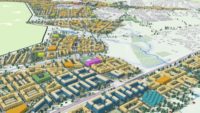
Technology First Read
Digital Twins Help Infrastructure Become Smarter
A digital twin for major infrastructure is only as good as the data that informs it

This digital twin of Rotterdam, Netherlands, uses a GIS basemap with information coded by color to identify buildings by age. Image courtesy of Esri

Jamaica station in Queens is one of New York City’s most vital transit hubs, a stop for most Long Island Railroad routes with connections to several subway lines and the AirTrain to John F. Kennedy International Airport. On weekdays, 200,000 riders make it the nation’s second-busiest commuter rail stop and the fourth-busiest train station overall. Anything that impedes its functions—such as problems with the tracks, railbeds, or signaling systems—could disrupt New York’s overall transit system.
Architects and engineers have always taken a long view when designing critical infrastructure, such as Jamaica station, mindful that their creations will need to remain robust well into the future. The era of climate change has both reinforced and complicated this imperative. Now, they must ask additional questions: How strong must a bridge be to withstand increased storm surges? How should new rail lines and roadways be constructed if once-a-century floods now occur every decade and at higher levels?
These questions demand a new approach. A “smart infrastructure” approach provides real-time insights for the present and data-driven planning for the future. This is possible thanks to the proliferation of sensors, other IoT devices, imagery data, historical data, and advanced analytics combined with geospatial technology that provides the context of geography. Key to planning and upgrading critical assets is understanding how infrastructure systems relate to communities and natural systems—what is happening where. That is why many construction professionals now use digital twins backed by a geographic information system (GIS). GIS software has the power to make sense of many different kinds of data and update it in real time. When geography and data are combined, infrastructure can be better managed for the greatest impact.
During a project’s planning stage, a GIS-powered digital twin can be used to run simulations and perform predictive analytics using location data to determine the effects of design decisions on the community and environment. As construction begins, the same twin may be used as a shared view of progress, ensuring that the process is unfolding as planned. It can provide a powerful diagnostic tool for understanding and modeling the effects of climate scenarios decades into the future and hundreds of miles away.
From a single train station to an entire network of railways and ports within a city’s supply chain, location-intelligent digital twins are enabling construction professionals to build smarter infrastructure for a continuously changing world.
Digital Twins and the Fifth Dimension
Jamaica station has recently undergone major renovations. HNTB Corporation, the engineer that won the contract, replaced critical power and signal systems, extended station platforms, and built two new tracks.
The work involved extensive use of what HNTB calls a “5D” digital twin. In addition to being a 3D simulation of real-world infrastructure, the twin integrates the dimensions of time and money. Linking the various stages of the project, the twin formed a record of progress as work moved from the design stage to construction. The tool helped to unite the many partner agencies and private sector contractors working on a construction project in one of the city’s most dense transit areas.
A digital twin can go beyond mirroring the project itself. It can be expanded to simulate how the project will affect—and be affected by—existing nearby systems.
This expansiveness has enormous value, allowing project managers to understand the ripple effects of climate change. For example, although Jamaica station itself may not be vulnerable to flooding, some of the routes that stop there travel through hurricane storm surge areas near Long Island’s Great South Bay. The interruption of those routes could potentially increase ridership on other routes, and Jamaica station must have the track infrastructure to adapt to these changes.
From Trains to Ports to Supply Chains
GIS and digital twins present advantages for regional rail systems, but also play a vital role in steadying and improving international supply chains.
Seaport Simulator, a predictive analytics tool developed by the engineering firm Atkins, helps major ports worldwide understand how a changing climate will affect their operations.
The program works by generating a digital twin of a seaport or trade area, including all supply chain nodes that link the port’s products to the rest of the world. This has direct relevance for port management. The Port of Prince Rupert in British Columbia, currently handles 35 million tons of cargo each year with plans for future growth and development. It moves cargo to and from Asian markets, and also connects to rail lines that carry it throughout North America.
With the digital twin in place, Seaport Simulator then uses a combination of historical local weather data and global climate model projections, generating thousands of possible realizations of estimated future weather across the supply chain of interest from present day to mid-century. It then simulates cargo moving through the supply chain while being disrupted by predicted future weather events.
Prince Rupert’s location has the continent’s second-highest rainfall, including hurricane-level storms, and a 25-ft tidal swing. The study conducted with Seaport Simulator gave the port’s management an idea of how a warming planet could affect operations through 2050, at a granular level of detail that helps management make specific changes and recommendations based on its estimates to their policies and infrastructure.
Of particular value to port managers is the big-picture view of the supply chain years into the future. It allowed supply chain managers to evaluate if a proposed improvement to a set of rail tracks hundreds of miles away from the port would be sufficient to handle events like atmospheric rivers, which are projected to intensify in future decades.
Location Intelligence at the Civic Scale
Able to depict entire cities and even nations, GIS-powered digital twins allow leaders to zoom out further. In the cities of Prague and Uppsala, Sweden, digital twins help city planners visualize how to transform old neighborhoods and create new ones, with an eye toward demographic projections and climate change mitigation.
In the South Korean city of Incheon, planners created a 3D base map from Lidar scans, and then built a digital twin for analyzing construction projects. It has evolved into a multi-purpose civic tool, used by sanitation, fire, traffic, facilities, development, and revitalization departments.
Island nations especially vulnerable to climate change are using GIS-based digital twins to understand how best to adapt. In Singapore, a “digital maritime atlas” is evolving into a digital twin that will reflect real-time changes in coastal areas. In Grenada, machine learning tools helped create the kind of realistic twin that would have otherwise required months and hundreds of work hours.
Once a spatially-aware digital twin is in place, it can evolve and adapt to community needs and new applications—acting as a location-intelligent system for the built physical world. As climate and population changes continue to impact our world and shape the way we design cities, we will need more of this intelligent, data-centric, and dynamic infrastructure.
Matt Piper is the Global Director for Industry Solutions at Esri and Leads the Utilities, Water and AEC Sectors. He is a professional engineer who has 20 years experience working in the utilities industry.


